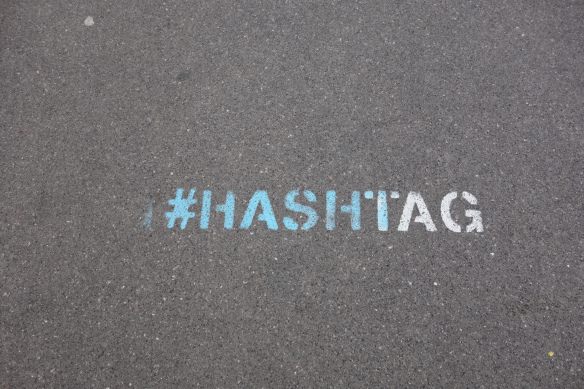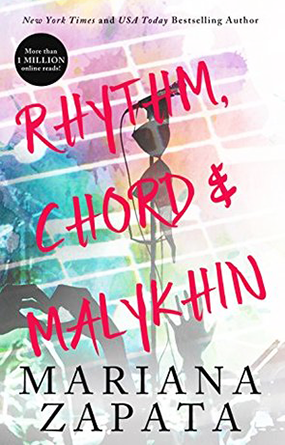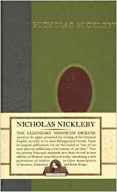
#HASHTAG by Petit Louis (CC-BY-2.0)
Last weekend, I finally got around to changing the light bulb over my front porch, after it had been out for several weeks. As I stepped down from the ladder, pleased with myself for having dealt with what had been annoying and inconvenient I said, “hashtag gettin’ stuff done”. (If this looks unfamiliar, perhaps #gettinstuffdone might resonate.)
In that moment, I realised the hashtag had become exclamation mark.
Most of us know, generally, the function of hashtags on social media, but they actually have many functions. The main one is topic-marking to aid searchability (Zappavigna, 2015a, 2015b) – their originally intended purpose (Caleffi, 2015, p. 46). Clicking on or searching for a hashtag takes the social media user to other potentially relevant conversations on a topic. In my tweet below, I use the hashtag ‘social media’ to mark the tweet as relating to that topic. The hashtag ‘ALC701’ also marks the tweet as relating to one of my postgraduate university subjects, but it does more.
#socialmedia and language, semantics and syntax #ALC701Context #ALC701
— Simone Reading (@SimoneReading) July 16, 2017
In using hashtags, we assume there is an ‘ambient audience’ (Zappa, 2015a, 2015b) for our tweets, that there are others interested in discussing these topics. In this way, the hashtag functions not only as topic-marker for subject classification and searching, but also to support the building of online communities and interpersonal relationships (Zappavigna, 2015a, 2015b). This is particularly relevant to the ‘ALC701’ hashtag in the tweet above, which helps draw together my student community.
Zappavigna (2015a) structured an analysis of the functions of hashtags in accordance with the three key functions of language identified within Systemic Functional Linguistics and defined as: ‘an experiential function of enacting experience, an interpersonal function of negotiating relationships, and a textual function of organising information (Halliday and Matthiessen, 2004 cited in Zappavigna, 2015a, p. 278 and 2015b, p. 31).
In the context of hashtagging, the experiential function relates to topic-marking and the interpersonal function incorporates the notion of ambient audiences and building communities. As a textual marker, the hashtag symbol (#) ‘acts as a form of punctuation’ (Zappavigna, 2015a, p. 279 and 2015b, p. 32) signalling the start of metadata (data about data), similarly to how a capital letter often signals the beginning of a sentence and a full stop its end.

Infographic created by Simone Reading using Canva.
Zappavigna expands on the interpersonal function of hashtags suggesting they may be ‘making an emotionally charged metacomment’ (2015a, p. 275) – a comment about a comment – and have the capability of expressing emotion (2015a, p. 285, 2015b, p. 33) In the tweet below, the hashtag #loveit is an emotional, evaluative comment on the remainder of the post.
Stunned that I’ve miscalculated an assignment due date #ALC701 and have a week longer than I thought #loveit
— Simone Reading (@SimoneReading) August 24, 2017
The Macquarie Essential Dictionary (2006, p. 272) defines an exclamation as ‘an outcry in response to feelings of protest, disgust, indignation, joy, or surprise’ (an expression of emotion) and an exclamation mark as ‘a punctuation mark used after an exclamation’.
If the hashtag symbol (#) is punctuation and a hashtag can express emotive comment, it follows that the hashtag can function as exclamation mark. In the tweet immediately above, I make an outcry, of sorts, in response to a feeling of joy and surprise (an exclamation) on realising I had an additional week to complete the writing of this post and I marked it as a hashtag. The hashtag, in this instance, indicates emphasis and tone the same way an exclamation mark in other written texts would do.
The exclamation mark, however, remains a textual feature to add emphasis and indicate how the written word should be interpreted in a conversational context. It is never spoken, except perhaps in the case of dictation.
Not only did my porch light bulb changing result in a ‘light bulb moment’ about the hashtag having become exclamation mark, it also revealed to me that the hashtag is no longer only a textual feature. It has morphed into a spoken word, which I explore in the embedded podcast below.
#thanksforreading
References
Caleffi, P 2015, ‘The ‘hashtag’: A new word or a new rule?, SKASE Journal of Theoretical Linguistics, vol. 12, no. 2, pp. 46-69
Zappavigna, M 2015a, ‘Searchable talk: the linguistic functions of hashtags’, Social Semiotics, vol. 25, no. 3, pp. 274-291
Zappavigna, M 2015b, ‘Searchable talk: the linguistic functions of hashtags in tweets about Schapelle Corby’, Global Media Journal: Australian edition, vol. 9, no. 1, pp. 27-37

Exclamation mark by Bastian Greshake (CC BY-SA 2.0)
Advertisements Share this:




